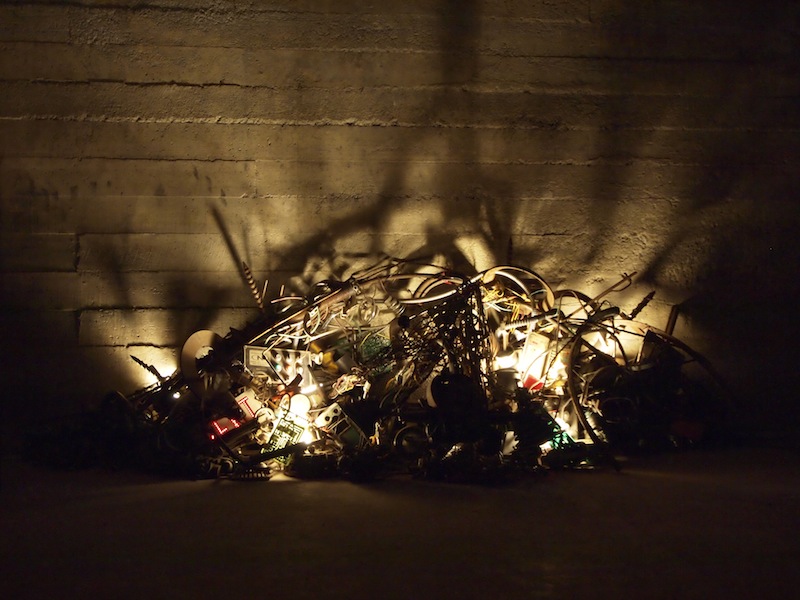The cavernous studio is nearly dark, its one window covered with a black cloth. Just a bit of light creeps in from the unsealed bay door, casting shadows and silhouettes on dozens of steely figured and wired webs. A steel, [John] Payne-ian dinosaur stands nearby, just in front and to the right of a 10-foot-wide heap of rebar, electric panels, wire and auto parts. Industrial artist Chas Llewellyn kills the lights, plunging the space into total darkness. A pipe organ rises out of two unseen speakers butted up against the studio’s farthest wall, where the pile of metallic refuse rests. The dinosaur isn’t the centerpiece, after all.
Tonight, Llewellyn will show an unusual exhibition, from 7 to 10-ish p.m. at his studio, on the farthest end of the Wedge Building’s back dock.
Llewellyn lets the music build for a few seconds before the first light brings the mound to life. A bulb flickers once, giving the eyes something solid to look at, for a moment. A few more seconds of darkness pass while the music continues to roar. The lights pop on and off more frequently. But as the coils heat up, they begin to fade a little slower, giving the piece a warm yellow-orange glow. A doorway exit sign and a control panel with red and green bulb covers add a little color to the aura.
After the initial sensory buzz edges off, one starts to see patterns developing. Each light fires up in response to a note blasting from the speakers. They respond to the highs, the lows and plenty of in-betweens.
Llewelyn is calling it “Junkatron,” and it’s pieced together by two separate artistic endeavors — the physical and the technological.
The structural aspect of the work is a product of the junkyard. The metal fragments and electrical components, even the exit sign — all pieced together from scraps. “The junkyard, it’s really a special place for me,” Llewellyn says. “It’s the stuff that humans have built and made, and then cast off.” It’s where most of his materials come from. “Junkatron” is an effort to replicate the character of the junkyard, the ebb and flow of waste and the constant state of transition.
Llewellyn spent two years of intensive computer programming to develop the controls. Lights and sounds are woven together by his made-from-scratch MAX MXB program. He operates the piece from a control panel perched aside the makeshift viewing area. To the untrained eye it’s an abstract techno-web spilled over several LCD screens. But it is in fact a linear map, containing dozens of active switchboards and circuits.
What used to only respond to pre-programmed music will now respond to a seemingly-infinite number of audio options. You can plug instruments into the program, play any number of songs from a variety of sources and players. He even uses an Animoog app on an iPad to fluctuate the lights. But it doesn’t limit itself to music. The program can recognize Twitter feeds and speeches, as he displayed with an MLK sermon. Llewellyn says the possibilities are near-limitless, as he’d like to implement ambient noise recording, from a gallery setting, to make the piece light up. The more noise generated by a gallery-going audience, the more reaction from the piece.
After two years of fine tuning, he’s decided that it is worth exhibiting. “Every day the software gets more sophisticated,” he says. “Now I think it’s at a point that I can show it.”
Llewellyn, who comes from a computer science background, has occupied the studio with fellow artist Tina Councell for more than four years now. Though they count themselves among the artists with uncertain leases that expire in the coming months. He and Councell are also among the dwindling number of people in the Wedge building, and the RAD for that matter, that worked directly under John Payne, the former building owner.
Llewellyn was introduced to Payne and his work at a 2007 studio stroll. He started working for and with him soon thereafter, just months before the artist and RAD staple would pass. After Payne’s death, he and Councell began working with Chris Payne, John’s former wife, on DINO-kenetics, the former Biltmore Park museum that housed Payne’s works. The collection has since been sold to Imagine Exhibitions, an Atlanta-based organization specializing in traveling exhibitions.
Payne’s work was notable for its extensive audience. “Anywhere from 3-year-olds to 80-year-olds,” as Llewellyn describes. “Very few people weren’t excited about giant metal dinosaurs.” It’s this same fondness for audience interaction that is driving Llewellyn’s work.



Before you comment
The comments section is here to provide a platform for civil dialogue on the issues we face together as a local community. Xpress is committed to offering this platform for all voices, but when the tone of the discussion gets nasty or strays off topic, we believe many people choose not to participate. Xpress editors are determined to moderate comments to ensure a constructive interchange is maintained. All comments judged not to be in keeping with the spirit of civil discourse will be removed and repeat violators will be banned. See here for our terms of service. Thank you for being part of this effort to promote respectful discussion.